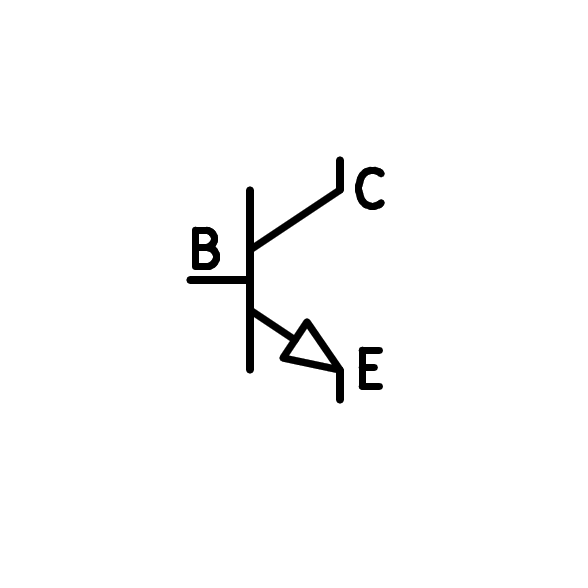6. The transistor¶
El transistor es un dispositivo electrónico de tres terminales que permite amplificar la corriente eléctrica. Tiene múltiples aplicaciones que van desde fabricar amplificadores de audio, osciladores de radio, controladores para motores eléctricos, fuentes de alimentación, circuitos digitales, microprocesadores, memorias, etc. El transistor forma parte de prácticamente todos los circuitos electrónicos.
The bipolar transistor¶
Es un tipo concreto de transistor basado en 3 zonas semiconductoras dopadas alternativamente como positivas y negativas. De ahí que existan dos transistores diferentes, un denominado NPN y otro denominado PNP, según el dopaje positivo o negativo de las tres zonas.
The names of the three terminals of transistors are: Collector, Base, and Emitter.
The symbols of the two bipolar transistors are as follows:

NPN bipolar transistor symbol.¶

PNP bipolar transistor symbol.¶
The operation of both types of transistors is very similar with the difference that the PNP transistor works with negative currents while the NPN transistor works with positive currents.
In practice, the NPN transistor is more used because it is more efficient when conducting electric current. For that reason it will be studied more in depth. The PNP transistor will be seen later in configurations that use both types of transistors, such as push-pull analog output or totem-pole digital output.
The transistor as an amplifier¶
In the following circuit we can experience the operation of a typical transistor-based amplifier.
The base-emitter junction of the transistor behaves like a diode, so it needs a voltage of 0.65 volts to be able to conduct current.
In the right sidebar there is a slider bar that allows you to change the value of the base bias resistor. This resistance allows a small current to pass through. The transistor amplifies the current that arrives through the base and allows a much larger current to pass from the collector to the emitter, multiplying the base current by the gain.
Transistor gain¶
The collector current in a typical transistor is 50 to 300 times greater than the base current. This relationship between the collector current and the base current is called gain of the transistor, also known as β or hfe parameter.
The transistor gain formula will therefore be:
Where the variables are:
β = hfe = transistor gain (dimensionalless number)
I_collector = collector current in amperes [A]
I_base = base current in amperes [A]
Note
Power transistors are transistors capable of conducting high currents, greater than one ampere. These transistors can have a gain of less than 50 when working with large currents.
The same happens with high-frequency transistors, which at operating frequencies close to their limit have a much lower gain than at low frequencies.
Exercises¶
Draw the symbol for the NPN transistor and the PNP transistor and add the names of each of their terminals.
What function does a bipolar transistor have?
Draw an electrical schematic of a working bipolar transistor. Add the currents and voltages that we can find in each of its three terminals.
Check that the simulated transistor gain is 100 by calculating the ratio of the collector current divided by the base current.
Slide the bar on the right called
Resistanceand check if the gain is maintained for various positions.When the base resistor lets too much current pass through, there comes a time when the transistor becomes saturated and cannot conduct any more current.
This is typical behavior in digital circuits, but is attempted to be avoided in analog circuits.
En el circuito de la simulación anterior, cambia la resistencia de Base por otra de 5k Ohmios. ¿Cuál es ahora la ganancia real del transistor? ¿Qué tensión hay en el colector cuando el transistor está saturado?